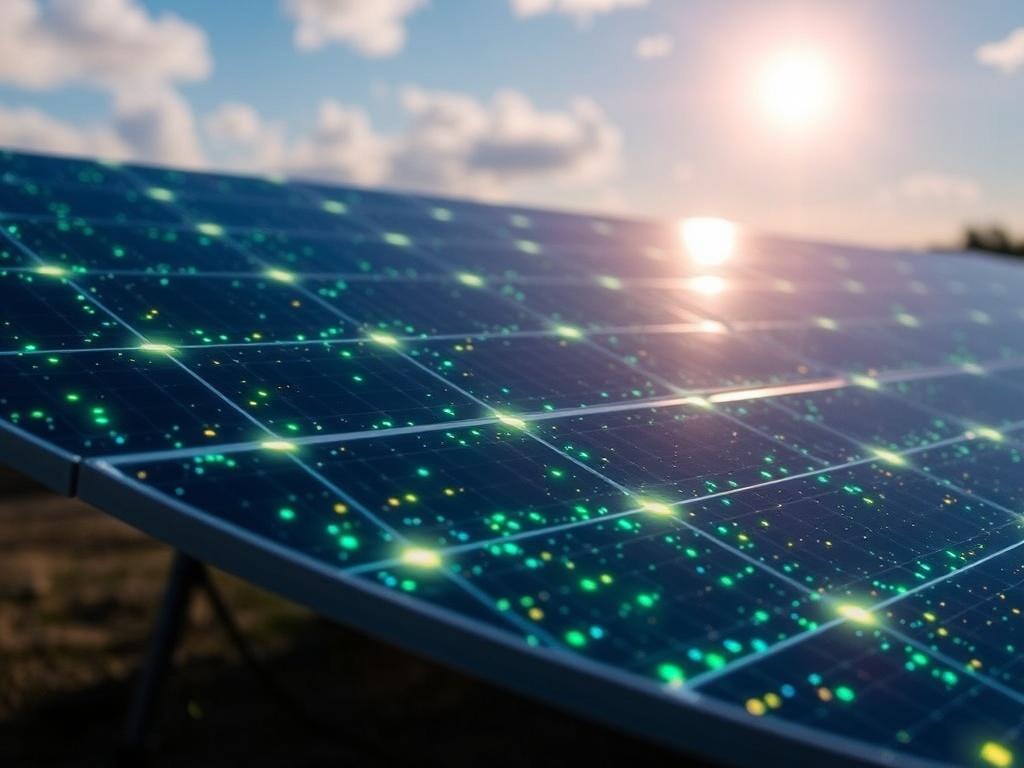- Understanding Quantum Dot Solar Cells
- How Do Quantum Dot Solar Cells Work?
- Key Advantages of Quantum Dot Solar Cells
- Challenges and Limitations
- Comparing Quantum Dot Solar Cells to Other Next-Generation Technologies
- Recent Advances and Breakthroughs
- Applications for Quantum Dot Solar Cells
- Economic and Environmental Implications
- Future Outlook: Are Quantum Dot Solar Cells the Next Big Thing?
- Steps You Can Take to Stay Informed and Engage
- Summary of Quantum Dot Solar Cell Features
- Conclusion
Understanding Quantum Dot Solar Cells
As our world moves toward cleaner and more sustainable energy sources, solar technology continues to captivate scientists and innovators alike. Among the newest breakthroughs in this field is the development of quantum dot solar cells, a technology that promises to increase efficiency beyond what traditional solar cells can achieve. But what exactly are quantum dot solar cells, and why is there so much excitement around them?
Quantum dots are tiny semiconductor particles, often only a few nanometers in diameter. Due to their incredibly small size, quantum dots exhibit unique electronic and optical properties that differ significantly from their bulk material counterparts. When applied to solar energy, these properties open doors to capturing sunlight in new and efficient ways.
Traditional silicon-based solar cells have been the industry standard for decades; however, they face limitations in efficiency and production costs. Quantum dot solar cells, on the other hand, leverage the size-dependent characteristics of quantum dots to absorb a broader spectrum of sunlight, potentially pushing solar cell efficiency to new heights.
How Do Quantum Dot Solar Cells Work?

To truly appreciate the potential of quantum dot solar cells, it’s helpful to understand the basic science behind their operation. A solar cell’s job is to capture photons—particles of sunlight—and convert them into electrical energy. In traditional cells, this process is done using silicon or other bulk materials that absorb photons within a specific range of energies or wavelengths.
Quantum dots behave differently because their size directly influences the energy levels within the particle. When sunlight hits a quantum dot, it excites electrons, creating what is called an exciton: a bound state of an electron and a hole. These excitons can then be separated to produce electric current.
One of the most remarkable properties of quantum dots is their tunability. By changing the size and material composition of the dots, researchers can tailor which wavelengths of light the quantum dots absorb. This means quantum dot solar cells can be engineered to harvest a wider range of the solar spectrum than conventional cells.
Furthermore, quantum dot solar cells have the potential for multiple exciton generation (MEG), which means that a single high-energy photon can generate multiple electron-hole pairs, boosting the current output from sunlight. This characteristic opens the door to surpassing the Shockley-Queisser limit—the theoretical maximum efficiency of traditional solar cells.
Key Advantages of Quantum Dot Solar Cells

Quantum dot solar cells bring several intriguing advantages over traditional photovoltaic technologies. Here is a look at some of the core benefits:
- Broad Spectral Absorption: Quantum dots can be tuned to absorb light over a wide range of wavelengths, including infrared light that traditional solar cells often miss.
- Cost-Effective Materials: Many quantum dots are composed of less expensive and more abundant materials than the pure silicon used in traditional cells, potentially lowering production costs.
- Flexible and Lightweight: Quantum dot solar cells can be fabricated on flexible substrates, which creates possibilities for their integration into a variety of surfaces, including wearable electronics and portable devices.
- Enhanced Efficiency Through MEG: The possibility of multiple exciton generation could significantly increase energy conversion efficiency beyond conventional limits.
- Low-Temperature Processing: Quantum dot solar cells can be made with low-temperature solution processing methods such as printing or spin coating, making manufacturing more scalable and energy-efficient.
Challenges and Limitations

While the promise of quantum dot solar cells is exciting, it’s important to acknowledge the hurdles that must be overcome before they become mainstream. Some technical and practical challenges include:
| Challenge | Description | Impact on Quantum Dot Solar Cells |
|---|---|---|
| Stability and Degradation | Quantum dots are susceptible to oxidation and photodegradation over time. | Limits the lifespan and performance consistency of solar cells. |
| Toxicity | Many efficient quantum dots use toxic elements such as cadmium or lead. | Raises environmental and health concerns, complicating commercialization. |
| Charge Carrier Extraction | Efficiently extracting charge carriers from quantum dots remains challenging. | Can cause energy losses and reduce overall efficiency. |
| Manufacturing Scalability | Consistency in large-scale, cost-effective production is still being developed. | Slows down commercialization and large-scale adoption. |
Despite these challenges, ongoing research is rapidly addressing many of these issues. For example, new quantum dot compositions based on less toxic elements like indium and zinc are emerging as safer alternatives. Protective coatings and encapsulation techniques are also improving the stability of quantum dots against environmental damage.
Comparing Quantum Dot Solar Cells to Other Next-Generation Technologies
The solar industry is bustling with innovation. Besides quantum dot solar cells, other promising technologies such as perovskite solar cells, organic photovoltaics (OPVs), and tandem solar cells are also in the spotlight. To better understand where quantum dots fit in, let’s briefly compare them.
- Perovskite Solar Cells: Known for rapid gains in efficiency and relatively low cost, perovskite cells are frontrunners in next-generation photovoltaics. They, however, face similar stability and toxicity concerns, especially with lead-based perovskites.
- Organic Photovoltaics: OPVs offer flexible solutions and low environmental footprint but typically have lower efficiencies and shorter lifespans compared to quantum dot or perovskite cells.
- Tandem Solar Cells: Tandem cells layer multiple absorber materials to harvest a broader spectrum of sunlight. Quantum dots can be integrated into tandem designs, potentially enhancing overall efficiency even further.
Quantum dots stand out because of their tunability and potential multiple exciton generation. Their unique physical properties can complement other technologies, creating hybrid systems that combine the best of each material’s capabilities.
Recent Advances and Breakthroughs
The pace of progress in quantum dot solar cell research is accelerating. In the past few years, researchers have achieved remarkable milestones:
- Lab Efficiency Record: Some quantum dot solar cells have surpassed 15% efficiency in lab settings, a significant leap toward commercial viability.
- Lead-Free Quantum Dots: Development of safer quantum dots based on non-toxic materials like copper indium sulfide has addressed environmental concerns.
- Improved Stability: Introduction of advanced surface passivation techniques has extended the operational lifespan of quantum dot solar cells.
- Integration Into Flexible Devices: Successful demonstrations of lightweight, bendable solar panels utilizing quantum dots have opened new application avenues.
These advances signal that quantum dot solar cells are no longer just a theoretical concept but are progressively moving toward real-world applications.
Applications for Quantum Dot Solar Cells
Where could this exciting technology be used? Beyond traditional rooftops and solar farms, quantum dot solar cells’ flexibility and lightweight nature make them ideal for a variety of uses:
- Building-Integrated Photovoltaics (BIPV): Windows, facades, or other architectural elements can incorporate quantum dots to generate power without compromising aesthetics.
- Wearables and Portable Electronics: Devices like smartwatches, fitness trackers, and phones could extend battery life by integrating flexible quantum dot solar panels.
- Remote and Off-Grid Power: Lightweight, portable solar generators utilizing quantum dots could provide power in rural or disaster-affected areas without infrastructure.
- Space Applications: The tunability and weight advantages make quantum dot solar cells attractive for satellites and space probes, where efficiency and mass are critically important.
As designs evolve and scale-up becomes feasible, the number of practical applications for this technology will continue to expand.
Economic and Environmental Implications
The adoption of quantum dot solar cells can have profound economic and environmental impacts. Let’s look at the potential benefits and considerations:
| Aspect | Potential Benefit | Considerations |
|---|---|---|
| Cost Reduction | Use of inexpensive materials and low-temperature fabrication can drive down manufacturing costs. | Initial research and development require considerable investment; market adoption pace uncertain. |
| Energy Efficiency | Higher conversion efficiencies translate to more energy generation per surface area. | Technical hurdles must be fully overcome to realize efficiency potential. |
| Environmental Footprint | Cleaner, more sustainable energy generation reduces reliance on fossil fuels. | Careful management of toxic materials is necessary to avoid pollution. |
| Job Creation | New manufacturing and research opportunities will create high-tech jobs. | Transitioning workforce from traditional solar technologies requires training. |
The move toward quantum dot solar cells also aligns with global efforts to meet carbon reduction targets, combat climate change, and enhance energy security.
Future Outlook: Are Quantum Dot Solar Cells the Next Big Thing?
Predicting exactly which technology will dominate the solar market in the years to come is challenging, but there is little doubt that quantum dot solar cells hold massive promise. Their ability to be engineered at the nanoscale and tailored for higher efficiency opens unique possibilities that traditional solar technologies cannot match.
As researchers continue to solve problems related to stability, toxicity, and scalability, quantum dots could become a mainstream solution capable of powering everything from city buildings to wearable gadgets. Moreover, their integration with existing solar cell technology in tandem structures could offer best-in-class performance for decades ahead.
Governments, companies, and academia are investing heavily in this field, signaling strong confidence in the future impact of quantum dot solar cells. Collaborations between diverse scientific disciplines—chemistry, physics, materials science, and engineering—are accelerating breakthroughs and bringing this technology closer to everyday use.
Steps You Can Take to Stay Informed and Engage
If you’re intrigued by quantum dot solar cells and want to keep up with the latest developments, here are some ways to stay in the loop:
- Follow Scientific Journals: Publications like Nature Energy and Advanced Energy Materials regularly feature cutting-edge research on quantum dots.
- Attend Conferences and Webinars: Events focused on photovoltaics or nanotechnology offer insights directly from industry experts and researchers.
- Engage with Industry News: Technology companies working on quantum dot applications often share updates through press releases and social media.
- Consider Educational Courses: Online platforms provide courses in renewable energy and nanomaterials that can deepen your understanding of the science behind quantum dots.
By staying informed, you can not only appreciate the science but also be ready for opportunities as quantum dot solar technology advances.
Summary of Quantum Dot Solar Cell Features
To wrap up the many facets of quantum dot solar cells, here is a quick table summarizing their key attributes compared to traditional silicon solar cells:
| Feature | Quantum Dot Solar Cells | Traditional Silicon Solar Cells |
|---|---|---|
| Material | Semiconductor nanoparticles | Crystalline silicon |
| Flexibility | Potentially flexible and lightweight | Rigid and heavy |
| Spectral Absorption | Tunable, broad spectrum including infrared | Fixed spectral range, mostly visible and near-infrared |
| Fabrication | Low-temperature, solution processing possible | High-temperature, energy-intensive processing |
| Efficiency Potential | High, potential to exceed Shockley-Queisser limit | Typical efficiencies around 15-22% |
| Lifespan | Currently shorter, improving with research | 20-30 years under standard conditions |
| Toxicity Concerns | Some materials toxic; alternatives in development | Generally low or manageable |
Conclusion
Quantum dot solar cells represent a fascinating frontier in the quest for efficient, cost-effective, and versatile solar energy solutions. Their nanoscale engineering, tunable absorption spectrum, and potential for multiple exciton generation mark them as an exciting candidate to leap beyond existing photovoltaic limits. While significant challenges remain—particularly concerning stability, scalability, and environmental safety—the rapid pace of research and innovation continues to push quantum dot solar cells closer to widespread practical application. As this technology matures, it promises a future where solar power is more efficient, flexible, and accessible than ever before, potentially transforming the way we harness the sun’s abundant energy for a cleaner planet.
Как вам статья?







